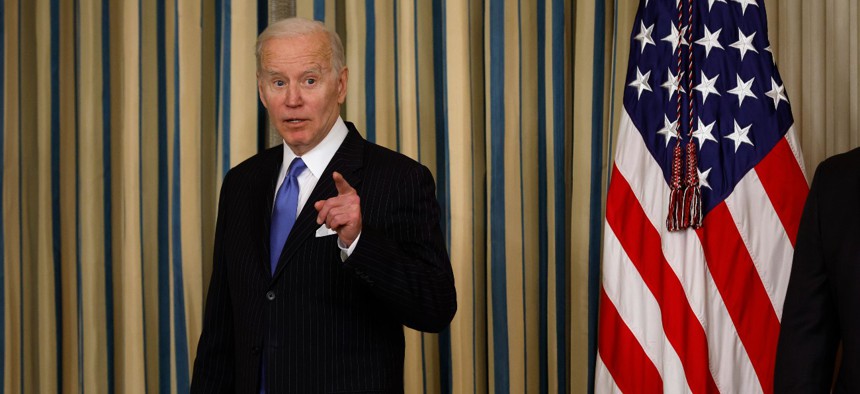Biden’s Management Agenda Update Adds Metrics to Workforce Goals

Chip Somodevilla/Getty Images
The White House’s first update to the president’s management agenda, first released last November, lines up tasks for agencies and attaches individual officials to goals.
The Biden administration on Thursday issued its first update to the president’s management agenda since it was released last November, establishing metrics for most of the document’s goals and making individual officials responsible for overseeing their implementation.
The management agenda, which puts empowering the federal workforce front and center to its goals of improving agency performance, set goals of making every federal job a “good job” and shifting to a more collaborative relationship between agencies and their federal employee unions, as well as improving the federal hiring process and attracting more young federal workers.
The first major update to the management agenda adds more detail to goals related to the federal workforce and improving customer experience, as well as metrics to measure agencies’ performance. Goals and metrics related to “the business of government” remain under development, the administration wrote.
In a blog post accompanying the update, the White House wrote that it is also assigning goals to individual officials across government as a way to improve accountability. A common refrain regarding past administrations’ management agendas has been that while often well-meaning, they rarely translate to actual transformation of government processes.
“OMB is also releasing the names of the team members from across government—strategy leads—who will ensure that PMA priorities and goals have the sustained attention they deserve and the focus and expertise of subject matter experts who drive day-to-day implementation,” the post states. “The priority area leads, strategy leads and their corresponding teams will use success metrics to track progress toward the Biden-Harris PMA priorities.”
The update sets four “priority goals” on federal workforce issues, each with its own success metrics: creating “more equitable” employee engagement, revamp the federal hiring process, attract new federal workers in mission-critical jobs, and promote diversity, equity, inclusion and accessibility practices across federal human capital management.
Among the metrics are narrowing gaps in employee engagement scores in the Federal Employee Viewpoint Survey by 20%, increasing the percentage of agencies meeting their mission-critical job hiring and staffing targets, and implementation of new diversity and inclusion Federal Employee Viewpoint measures, which are still being finalized.
Digging deeper into federal hiring reform are goals aimed at identifying barriers to diversity in the hiring process, increasing the number of jobs that are enrolled in the new continuous vetting process to reduce the backlog on background investigations for new hires, and increasing the percentage of job applicants who receive status updates on where they stand in the hiring process.
The management agenda also tasks agencies with ensuring that diversity, equity, inclusion and accessibility is more central to federal managers’ job responsibilities, setting a goal of increasing the percentage of Senior Executive Service and other employees in leadership who have diversity-related metrics in their individual performance goals, as well as developing more opportunities for employees to engage in professional development.
“All agencies will conduct barrier analyses on both the senior leadership pipeline and employee retention rate with respect to institutional/structural, attitudinal and physical barriers, and act on findings of those analyses,” OMB wrote.
And an entire section of the management agenda’s workforce-related “strategies” document is devoted to OPM’s effort to reform itself into a 21st century policy leader on human capital management. Last week, the agency published a five-year strategic plan outlining how it plans to implement recommendations from the National Academy of Public Administration.
By fiscal 2026, OPM is expected to improve its “Leaders Lead” score in the Federal Employees Viewpoint Survey by three points, and it should ensure at lest half of Chief Human Capital Officer survey respondents who “strongly agree that OPM treats them as a strategic partner.”






